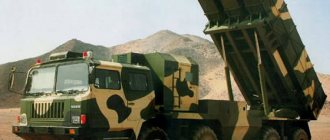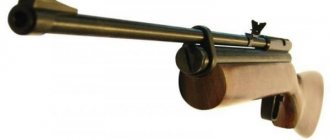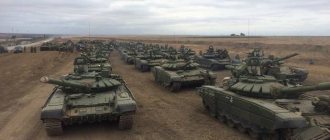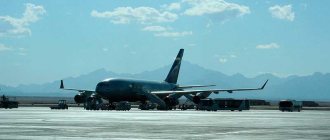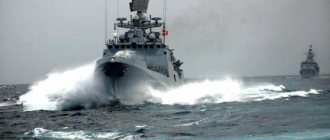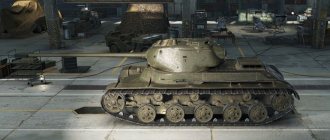Modern anti-aircraft machine gun installations
The PLA widely uses MANPADS and anti-aircraft heavy machine guns to provide air defense to company- and battalion-level motorized rifle units.
In the 21st century, the bulk of the 12.7 mm Type 54 and Type 54-1 machine guns, created on the basis of the DShKM, were replaced by modern Type 85 and QJZ89 (Type 89) machine guns. Compared to the DShKM, the weight of the new Chinese 12.7 mm machine guns is significantly reduced.
While maintaining the rate of fire and range the same as that of early Chinese 12.7 mm machine guns, the new Type 89 machine gun (offered for export as QJZ-89) was made record-breakingly light, its weight in the firing position on a universal tripod machine is 32 kg .
12.7 mm Type 89 machine gun
The 12.7 mm Type 89 heavy machine gun uses a mixed type of automation: to unlock the rotating bolt, a gas exhaust mechanism is used with direct exhaust of gases from the barrel bore to the bolt through a gas tube under the barrel, and to drive the automation, the recoil energy of the moving block is used.
The machine gun's controls include a pistol grip with a trigger and a stock with a shock-absorber buffer. The machine gun is placed on a special lightweight tripod, allowing firing at both ground and air targets. The machine gun is equipped with a standard optical sight, although mechanical sighting devices are also provided.
Type 89 machine gun on the PLA Navy frigate Type 054A
Development of this machine gun began in the late 1980s, and it was noticed by foreign observers in 1997. According to foreign experts, the 12.7 mm Type 89 machine gun is mainly intended for airborne troops and mobile rapid reaction forces. It is also used by the PLA Navy for close-in self-defense of warships.
In 2002, the 14.5-mm QJG 02 anti-aircraft gun was adopted, which is gradually replacing the Type 75, which is a copy of the Soviet ZGU-1, in the military.
14.5 mm anti-aircraft gun QJG 02
The QJG 02 large-caliber machine gun uses automatic gas venting with a gas piston located under a quick-change barrel. The barrel is locked by a rotating bolt; fire is carried out only in automatic mode, from an open bolt.
The machine gun can use all types of 14.5 mm cartridges, including new Chinese-developed armor-piercing cartridges with a sub-caliber bullet in a detachable tray, having a muzzle velocity of 1,250 m/s and armor penetration of 20 mm of armor at a range of 1,000 meters at an impact angle of 50°.
The weight of the machine gun together with the machine is 75 kg. The weapon can be disassembled into several parts weighing no more than 20 kg, which allows the QJG 02 machine gun and its supply of ammunition to be transported over considerable distances by the infantry squad.
The capacity of the tape, divided into detachable links of 5 cartridges, is 50 cartridges. Rate of fire – 600 rounds/min. Combat rate of fire – up to 100 rounds/min. In 2007, foreign buyers were offered an improved QJG 02G machine gun, in the design of which titanium alloys are widely used.
A coaxial machine gun mount is designed for installation on armored vehicles, various vehicles and patrol boats. It is reported that 14.5-mm QJG 02 machine guns are primarily supplied to mountain rifle brigades stationed in the southwestern part of the People's Republic of China and air defense units deployed along the Formosa Strait.
These weapons were exported to Iran and Iraq, as well as to a number of African countries.
35 mm anti-aircraft guns
In 1987, China purchased several Oerlikon GDF-002 35 mm twin anti-aircraft artillery mounts and a Skyguard radar system from Switzerland.
35 mm anti-aircraft guns and Skyguard fire control radar
In the original version, the anti-aircraft fire control station with a crew of two people was located in a towed van, on the roof of which a rotating pulse Doppler radar antenna, a radar rangefinder and a television camera were installed.
After a thorough study of the installations and guidance station, Chinese specialists began technological copying of the acquired samples. In 1999, a replica of a locally produced anti-aircraft gun, designated Type 90 (sometimes referred to as Type 99), was shown at a military parade in Beijing.
35-mm Type 90 anti-aircraft gun with guidance station
A rotating carriage with a twin 35-mm artillery unit is mounted on a two-axle trailer with jacks, there is also an operator's seat with controls, a sight, two magazines with 280 rounds each and additional ammunition. A towed 35-mm twin anti-aircraft gun in combat position weighs 6,700 kg. Effective firing range against air targets is up to 4,000 m, height reach is 3,000 m. The total rate of fire from two barrels is 1,100 rounds/min. The magazine is reloaded in just 7.5 seconds. Firing range at air targets is up to 4,000 m.
Each 35-mm twin anti-aircraft gun is connected via cable lines to a Type 902 fire control station, which is mounted in a van on an off-road army truck chassis. Compared to the original model, the Chinese Type 902 fire control system has significantly greater capabilities.
The detection range of air targets by radar is up to 35 km. Accompanying range is 15 km. Due to the introduction of a laser rangefinder and an optoelectronic optical system, it was possible to significantly increase the effectiveness of the fight against UAVs, cruise missiles, airplanes and helicopters operating at low altitudes.
It is possible to fire at visually invisible targets: at night and in difficult weather conditions. In this case, data on the target's course, altitude and flight speed are transmitted to anti-aircraft installations via a wired communication channel from the guidance station, the aiming of 35-mm twin machine guns is carried out in an automated mode, and the crews give the command to open fire, control the availability of ammunition and replenish the shell boxes. The reaction time from the moment the target is detected to the opening of fire is no more than 6 seconds.
Chinese experts note that compared to 37 mm twin installations, the 35 mm Type 90 is made using modern technical solutions. High automation allows the battery to be aimed by one operator, and the automatic loading system has increased the practical rate of fire.
According to information published in open sources, the PLA is armed with more than 200 Type 90 towed installations.
To increase mobility, approximately 60 35-mm anti-aircraft guns are mounted on the chassis of a three-axle Shaanxi SX2190 off-road cargo truck. This SPAAG is known as the CS/SA1.
35mm ZSU CS/SA1
Firing can be carried out either remotely or from the gunner's position. The AF902A fire control system is an improved version of the Type 902 fire control system, mounted on a separate towed trailer and equipped with a radar with a target detection range of up to 40 km, as well as an optical-electronic tracking module and a ballistic computer.
Although 35-mm anti-aircraft guns are quite mobile, they are for the most part stationary, in well-prepared engineering positions. Batteries of 35-mm Type 90 spark plugs are mainly located on the coast of the Formosa Strait, as well as in the vicinity of airfields, ports, strategically important bridges and tunnels.
In 2007, tests began on the 35-mm ZSU, which, after being put into service, received the designation 09 (PGZ-09). This vehicle, on the chassis of a 155 mm Type 05 self-propelled howitzer, is armed with two 35 mm PG99-35-2 cannons - the Chinese version of the Oerlikon KDA, which are also used in the 35 mm Type 90 towed installation.
35mm ZSU Type 09
The vehicle's turret has a rotating search radar antenna with a detection range of 15 km. In front of the tower there is a parabolic antenna for a radar rangefinder. In the event that the enemy uses electronic warfare and there is a threat of being hit by anti-radar missiles, it is possible to search for air targets using a passive optoelectronic station with a laser range finder.
It is reported that the latest modification of the ZSU is equipped with a new day camera and thermal imager, which makes it possible to effectively use the 35-mm installation around the clock and in any weather conditions. In addition, improvements have been made to the radar system, which can operate in a mode that significantly complicates the targeting of anti-radar missiles.
A diesel engine with a power of 800 horsepower allows a car weighing 36 tons to reach a maximum speed of 65 km/h on the highway. Thanks to its good specific power, the ZSU feels confident even on very rough terrain. Cruising range on the highway is 450 km. Armor protection provides protection against small arms fire and light shrapnel.
According to Western experts, the Type 09 SPAAG in terms of its ability to hit air targets corresponds to the German modernized Gepard SPAAG, but the Chinese vehicle is much lighter.
Type 09 ZSU divisions are assigned to tank regiments; in total, the PLA has approximately two hundred 35-mm anti-aircraft self-propelled guns.
Relatively recently, a version of the 35-mm ZSU on the chassis of a wheeled armored personnel carrier was presented. This vehicle is intended to accompany transport convoys, and to operate as part of motorized rifle units equipped with wheeled armored vehicles.
If you can’t see the difference, Ankara is interested in Chinese copies of Russian air defense systems
The Turkish Ministry of Defense has summed up the preliminary results of the tender for the supply of long-range anti-aircraft missile systems. According to unofficial data, the military intends to purchase Chinese HQ-9 systems, which are a modified copy of the Russian S-300P. It is noteworthy that the original S-300 is also participating in this competition, which does not suit the Turkish Ministry of Defense for reasons that can only be guessed at this time. Meanwhile, the purchase of Chinese anti-aircraft systems will not allow Turkey to integrate them into a unified NATO air control system and, in fact, will turn the Turkish air defense system into a patchwork quilt.
The fact that Turkey is seriously considering the possibility of purchasing Chinese HQ-9 systems was reported by Defense News, citing its own sources in the Turkish military department and air defense forces. The military department made a preliminary choice in favor of the Chinese proposal, allegedly because it turned out to be technically adequate and the cheapest. In addition, the source said, Beijing does not object to the transfer of a number of HQ-9 technologies to the Turkish side, adaptation of the complexes to Ankara’s requirements and the creation of joint production of anti-aircraft systems in Turkey.
The choice of the Turkish Defense Ministry must be approved by Defense Minister Ismet Yilmaz and Prime Minister Recep Tayyip Erdogan. The final decision is expected to be announced at a meeting of the Defense Industry Council (DIEC) of Turkey, the date of which has not yet been set. The purchase and adaptation of anti-aircraft systems will be carried out following the results of the large-scale T-Loramids tender announced by Turkey in 2009. It is planned to spend at least four billion dollars on the purchase of air and missile defense systems, however, taking into account the modification of the complexes to Turkish requirements, this amount may be higher.
Participating in the Turkish competition are a consortium of American companies Raytheon and Lockheed Martin, Rosoboronexport, the Chinese company China Precision Machinery Import-Export Corporation (CPMIEC) and the European consortium EuroSam. They offer the military the Patriot PAC-3, S-300, HQ-9 and SAMP/T Aster 30 anti-aircraft systems, respectively. In January 2013, it was reported that the Turkish Ministry of Defense canceled the tender, deciding to develop its own anti-aircraft missile system with the support of a foreign partner. In fact, there was no talk of canceling the competition. All applications submitted by foreign participants were recognized as valid, and the tender conditions were supplemented only by the requirement to adapt equipment and transfer production technologies.
| Comparison of anti-aircraft systems | ||||
| Patriot PAC-3 | SAMP/T | S-300 | HQ-9 | |
| Damage range, kilometers | up to 80 | up to 120 | up to 200 | up to 200 |
| Damage height, kilometers | 24 | 20 | up to 27 | up to 30 |
| Target detection range, kilometers | up to 180 | up to 80 | up to 300 | up to 120 |
| Simultaneous target tracking | up to 125 | up to 130 | up to 200 | 100 |
| Maximum target speed, meters per second | up to 2200 | ~2300 | up to 2800 | ~2000 |
| Missile interception capability | There is | There is | available with special radar | available with special radar |
| Number of missiles on the launcher | up to 16 | 8 | 4 | 4 |
| Own radar | There is | There is | There is | There is |
Until recently, it seemed that Ankara would prefer either the European or the American proposal. This forecast was supported by the fact that Turkey has been a member of NATO since February 1952 and tries to adhere to the military standards of the North Atlantic Alliance. In particular, the basis of the Turkish air defense system is the American anti-aircraft missile systems MIM-14 Nike-Hercules, MIM-23 Hawk XXI, British-Turkish Rapier, American-Turkish FIM-92 Stinger and national Atilgan PMADS. A network of American-made radar stations, including the powerful AN/TPY-2 in Malatya, is responsible for air defense information support. In addition, Turkey also receives air defense data from the European automated control system for NATO air defense forces and assets.
Finally, at the height of the civil war in Syria, Turkey asked the United States, Germany and the Netherlands to temporarily deploy six batteries of Patriot complexes on their territory. Currently, they cover the Turkish-Syrian border in areas of cities such as Adana, Kahramanmaraş and Gaziantep.
Nevertheless, the participation of Russian and Chinese complexes in the Turkish tender causes NATO concern. In particular, in August 2011, the leadership of the North Atlantic Alliance for the first time openly intervened in the competition, asking Ankara to refrain from purchasing the S-300 or HQ-9. Official representatives of Brussels justified their request by the impossibility of connecting Russian or Chinese systems to the unified NATO airspace control system. Later, Ankara received several more similar warnings, one of which came from Washington. Thus, the information that Turkey is leaning in favor of the HQ-9, although not officially confirmed, seems to still have some basis.
If all these assumptions are correct, then the situation that has developed around the purchase of anti-aircraft missile systems by Ankara looks, on the one hand, comical, and on the other, impractical. The funny thing is that Turkey intends to buy Chinese copies of the S-300P instead of the original, albeit somewhat more expensive, S-300. At the same time, Beijing itself, which actively supplies HQ-9 to its troops, prefers to cover the largest Chinese cities with Russian complexes, rather than with its own modified copies. In particular, in 2010, Russia completed the delivery to China of 15 divisions of the S-300PMU-2 complexes, which defended Beijing and Shanghai. This fact is a kind of compliment to Russian manufacturers, and it also causes bewilderment regarding Ankara’s preliminary choice.
The Turkish impracticality lies in the fact that the purchase of Chinese (as well as Russian) complexes will entail a whole chain of intractable problems. In particular, it will be difficult for Turkey (and even impossible without the consent of the United States and NATO) to integrate the HQ-9 complexes into a unified air defense system. The fact is that for this, Turkey will have to order from the Chinese supplier the modification of a number of systems to ensure compatibility with NATO standard equipment. In this case, it will be necessary to request technical information from the alliance about the operation of their equipment, and the transfer of such information to China is fraught with the leakage of classified information.
Patriot PAC-3
Photo: US Air Force
Previously, NATO representatives have already stated that connecting Russian or Chinese complexes to the NATO air defense system will allow Moscow or Beijing to gain access to important intelligence data, and such integration will not have the opposite effect ─ the alliance will not gain access to classified information from Russia and China. However, even without integration, the HQ-9 can be used to effectively cover important targets, since the complexes have their own radars and are capable of operating independently of a unified air defense system. However, even in this case, Türkiye will face certain difficulties. We are talking about the exchange of codes according to the “friend or foe” system.
According to Flightglobal MiliCAS, the Turkish Air Force operates 227 American-made F-16C/D Fighting Falcons, 152 F/RF-4E Phantom IIs and F/NF-5A/B Freedom Fighters. The friend-or-foe transponders of these aircraft are configured to the standard NATO recognition system, and their pairing with the interrogation systems of the HQ-9 complexes will be impossible. First of all, because NATO will not agree to disclose information about its code system and information exchange, and without this it will not be possible to set up Chinese friend-or-foe recognition systems. It is theoretically possible to retrofit fighter aircraft with transponders compatible with the HQ-9 complexes, but such a solution looks extremely doubtful. In particular, it will be difficult to ensure compatibility of two identification systems of different types on one aircraft.
The Turkish tender is becoming increasingly unpredictable as the Defense Ministry's motives remain unclear. On the one hand, if Ankara needs to strengthen its existing air defense system, then it is obvious that American or European anti-aircraft systems are best suited for this. On the other hand, given the growing armed conflict in Syria, Turkey may experience an urgent need to urgently cover the state border with this country, which means the low cost of the systems and the speed of their delivery play an important role. In any case, what exactly Ankara will choose will be known in the coming months, but for now you can place your bets.
